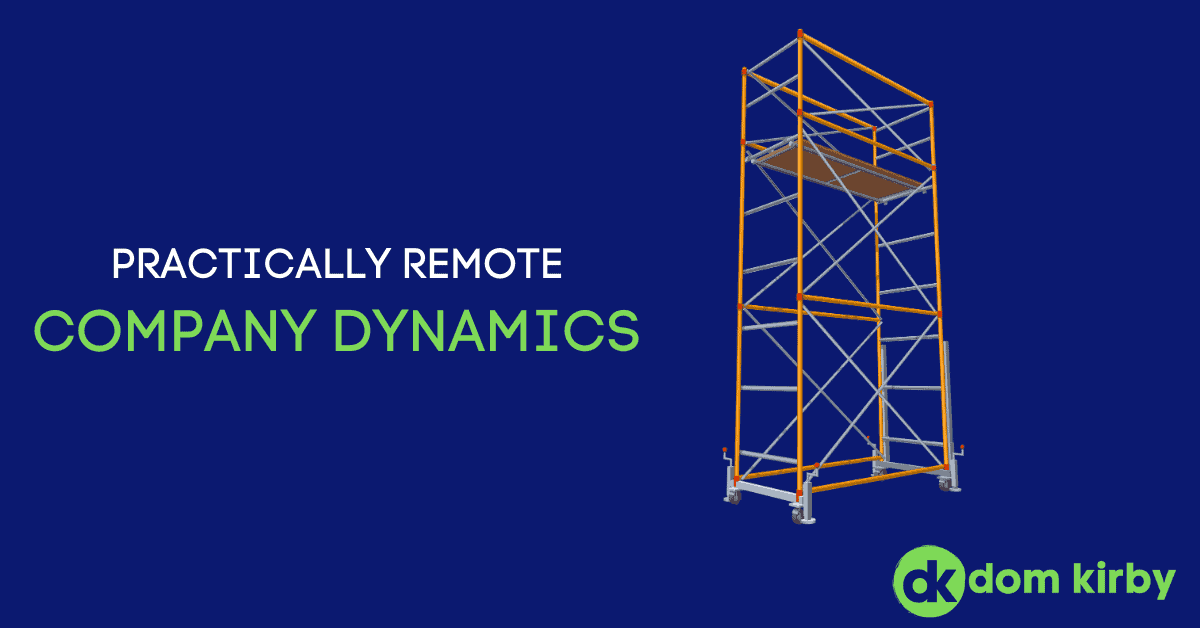For the first iteration of ‘practically remote,’ I think the topic of “company dynamics” make the most sense. You could also think of it as company structure, but I don’t want to put this topic in a box, let’s let it breathe! So with that in mind, I define company dynamics as making sure your company can operate regardless of the working situation.
If your team doesn’t function as a smooth unit with a common mission in the office, it’ll be hopeless if they’re remote! Especially if people are in different time zones.
Note: I use the terms company, team, and organization interchangeably. In any case, these thoughts apply to your whole company or your whole team if you’re leading a remote team within another company.
It’s About People
First thing’s first. It’s always about people. The people in your organization are key to making it work, period. No amount of leadership will fix things if you don’t have the right people doing the right things. And even if you have amazing talent, they will not be the as effective as they can be if they aren’t being led. Leadership will be the next topic, but let’s talk about organizing your company so that it isn’t just a gaggle of random tasks.
Accountability and Defined Roles
When you’re in that little baby startup state, the idea of an accountability chart rarely sees the light of day. However, I think that’s a grave mistake. If your company consists of more than one human, I think an accountability chart is key.
Everyone in your team should understand their role and areas of responsibility. This makes the task of splitting the work much easier and gives your people the opportunity to take accountability and initiative (see the work in my AO, take it). Remote or not, this sort of accountability chart brings a lot of clarity to a team.
I’ve tried a lot of methods for this, but I really like the method laid out in “Traction” and the Entrepreneurial Operating System. Traction is a really, really good read for any leader.
Org Chart/Reporting Structure
Another small business plague (guilty as charged) is a lack of a defined reporting structure. It may seem like overkill for a small business, but I argue that people (including me) like knowing who they work for.
Broadly, I prefer a “straight up” military chain of command style org chart. Leaders need to be in the right places, leading the right people, and there needs to be an apex at the top. If you’re the owner of a small business, everyone might report to you. That’s okay! Build that structure now and it’ll be easier to grow.
By the way: While I believe in the chain of command structure, it is not an excuse for middle and senior leaders to shut people out. An open-door policy is critical!
Defined Work Methodology
This is a big one! Having defined work methods and documented practices on any team brings several benefits.
Firstly, it provides clarity and consistency in how tasks and processes are executed. When everyone follows established methods, it minimizes confusion and ensures that work is done efficiently and effectively. Having things documented also helps as you grow your organization.
Defined work methods also drive accountability and create measurable metrics. I’ll dive more into this on the leadership topic, but the book “Remote” covers it well. They call it “managing work” instead of “managing seats.” Long story short, document work processes are even more critical in the remote work world.
Furthermore, remote or not, “tribal knowledge” will kill your business. if your star team member leaves tomorrow, how will you get their replacement up to speed? Having their processes documented is the only way to do it smoothly. I’m working on improving this with my teams at Pax8 now, and it has been game-changing!
In the remote world, your knowledge tool needs to be in a central place that is securely accessible from anywhere. Here are few products that I’ve used or seen used before:
- Confluence
- Guru
- MediaWiki (though this one is rather nerdy, be warned)
- SharePoint Wikis
- Shared OneNote
- IT Glue (for MSPs)
We’ll dive more into tools in later topics on collaboration and productivity as well. One tip here, separate the need for knowledge capture from operations. Your operations tool might suck for knowledge management, don’t be afraid to use separate tools.
Empowered People
This is more of a “what” and less of a “how.” We’ll talk more “how” on the leadership topic. Your people need to be empowered to execute within their full area of operations. Some people might work different hours than others, or their leader might be sick. Give people more autonomy, more ownership, over their outcomes. You could also sum this up as trusting your people.
Defined Mission and Vision
I stole this bit right out of Traction, and a bit from the school of hard knocks. Sometimes the documented process or a person’s responsibilities don’t answer a question. Outside of the obvious benefits of mission and vision, there’s an operational gain too!
When in doubt, does this request or task align with the company’s mission and values?
It’s a simple question but helps a team member find clarity when they get that off that wall weird customer request to deal with (or a similar situation).
There’s a lot more to this from a company dynamics perspective, and I may even do another piece on this topic. However, these are some of the top things I’ve found myself thinking about while leading a remote team.




